What Is Email Marketing?
Email marketing involves sending targeted messages to subscribers’ inboxes to inform them of new products or services, boost brand awareness, and increase sales.
Marketing emails can be used to:
- Engage: Keep subscribers informed and interested in your brand with compelling content, from shoppable blog posts to how-to guides
- Inform: Ensure customers stay up-to-date on new product launches or business policy changes
- Convert: Increase sales through emails that feature special discounts or exclusive deals
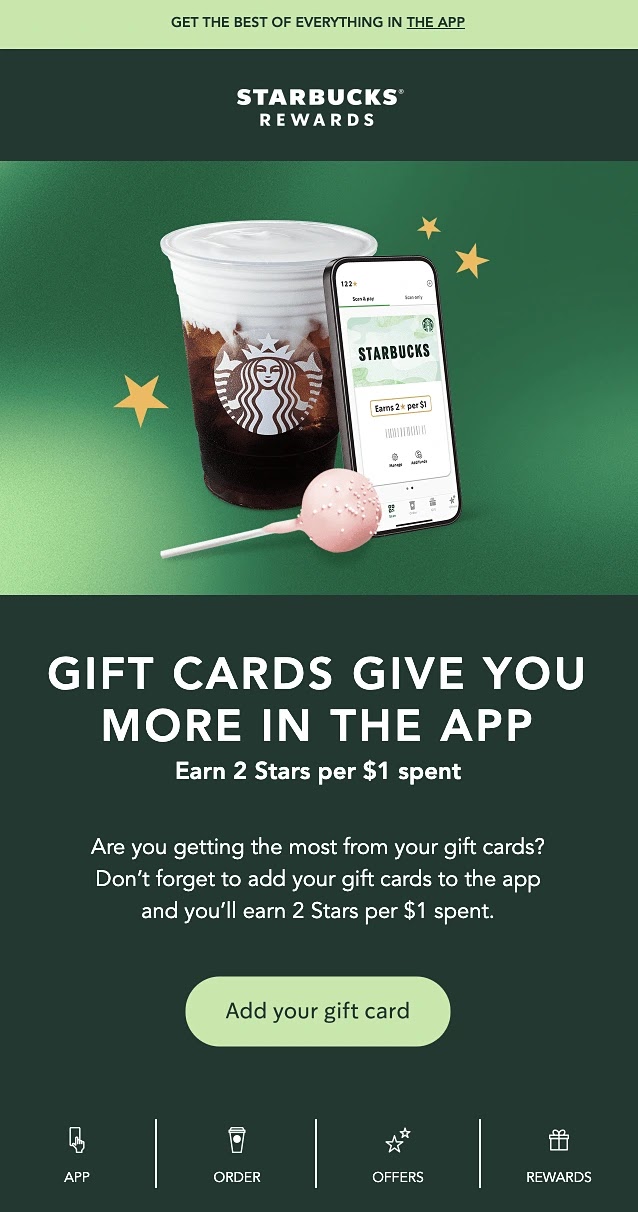
Types of Marketing Emails
No matter what type of email you send, set a goal for it. This could include educating customers, increasing brand awareness, or driving a specific action, like visiting your website, signing up for a free trial, or making a purchase.
There are five main types of marketing emails:
- Newsletters: Regular updates that keep your audience informed about your business, industry news, or other relevant topics
- Promotional emails: Messages designed to promote special offers, new product launches, or exclusive deals
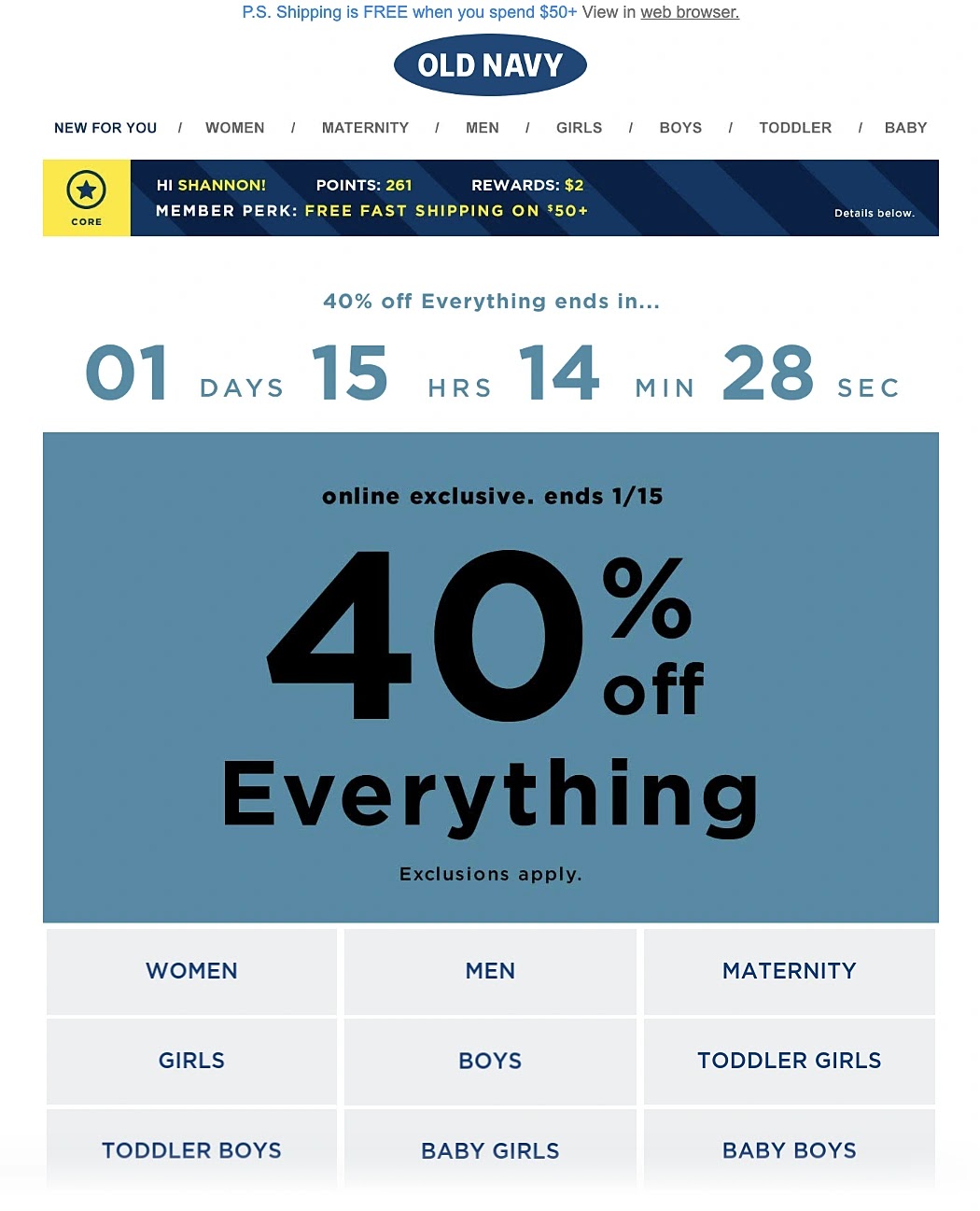
- Transactional emails: Order confirmations, receipts, and other communications that occur as a result of a customer's interaction with your business
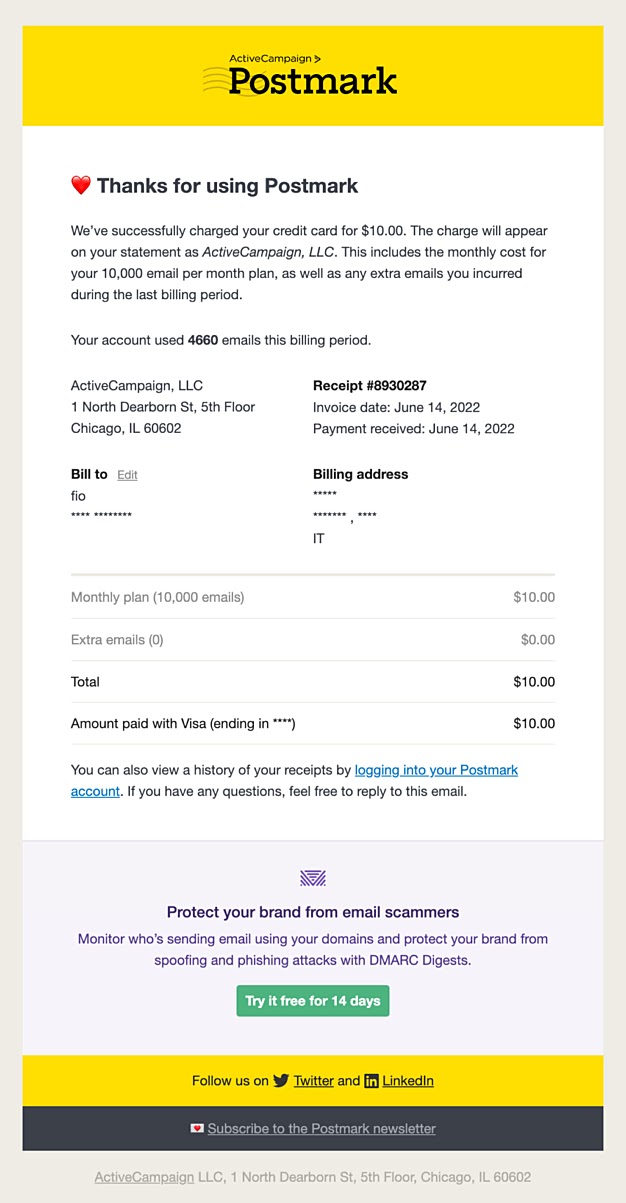
Image Source: Postmark
- Re-engagement emails: Rekindles interest among subscribers who have not interacted with your previous emails
- Welcome emails: Brand introduction emails sent to greet fresh subscribers or purchasers, setting the tone for future communications
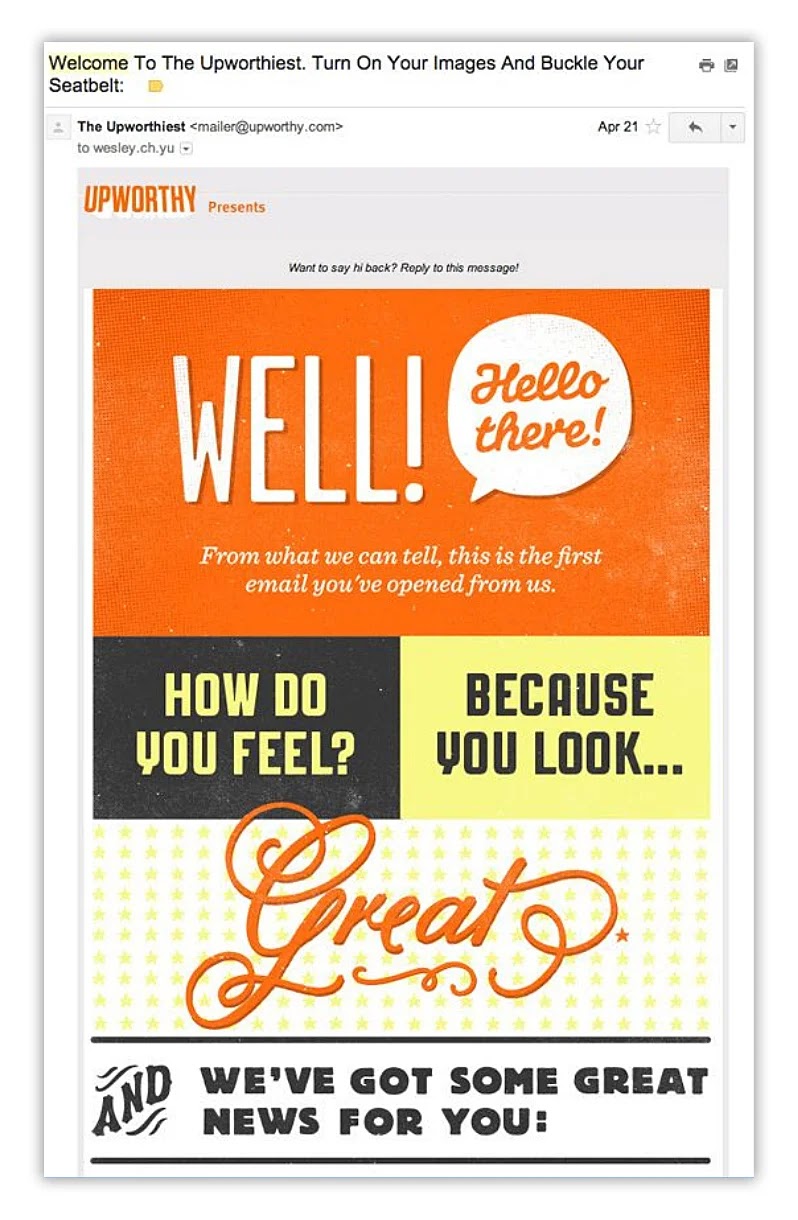
Image Source: Mailmunch
Email Marketing Benefits for Your Business
Email marketing is vital to a well-rounded digital marketing strategy because it allows you to connect with customers on a personal level.
Here’s a look at some of the biggest benefits:
High ROI
Email marketing ranks as the most efficient direct marketing channel, achieving an impressive average return on investment (ROI) of $36 for every dollar invested.
This makes it a cost-effective way to reach your customers on a regular basis.
Targeting and Personalization
Personalized messages tailored to your subscribers' interests and behaviors make your email content more relevant and engaging.
According to a 2021 Litmus report, nine out of 10 marketers recognize personalization as key to their business strategy.
In fact, 80% of customers are more inclined to buy from brands offering personalized experiences.
Personalized emails often prove effective and lead to higher conversion rates. Some studies show personalized emails deliver transaction rates six times higher than non-personalized ones.
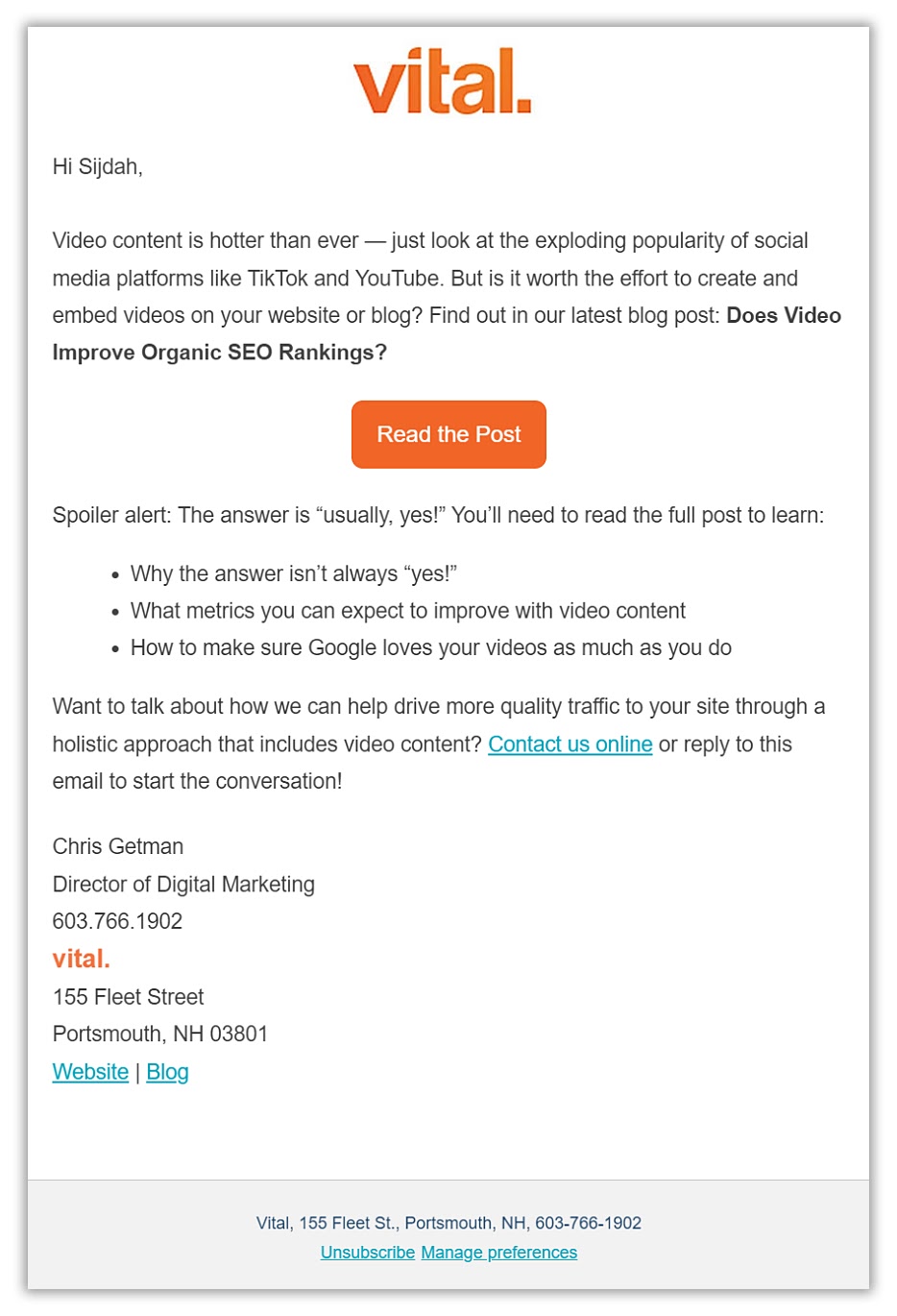
Personalized targeting makes communication more meaningful and potentially more effective.
Personalization can range from simple gestures like using the subscriber's name to more complex targeting based on their interaction history with your brand.
For example, if a customer frequently views a particular category of products on your website, send them tailored emails highlighting new arrivals or exclusive deals in that category.
If a customer views a product several times or adds it to the cart but doesn't purchase it, send an email highlighting that product along with a time-sensitive discount.
Easy to Analyze
Email campaign effectiveness can be measured using various metrics like opens, clicks, and conversion rates.
For example, a high open rate might indicate compelling subject lines. An impressive click-through rate could suggest engaging content.
Conversion rates reflect an email's success in achieving a desired action from recipients, whether a purchase or a lead.
Building Relationships
Regular, personalized communication through emails can help build and maintain customer relationships.
According to Optinmonster, 99% of email users check their inbox daily, with some individuals reviewing emails up to 20 times a day.
This gives you many opportunities to connect with customers through email marketing.
Create content beyond sales, providing value and news. For instance, track customer purchases to recommend future products, send birthday vouchers, and offer exclusive deals to subscribers.
Sephora’s birthday offer is one of the best email marketing examples of surprising and delighting customers in their inboxes.
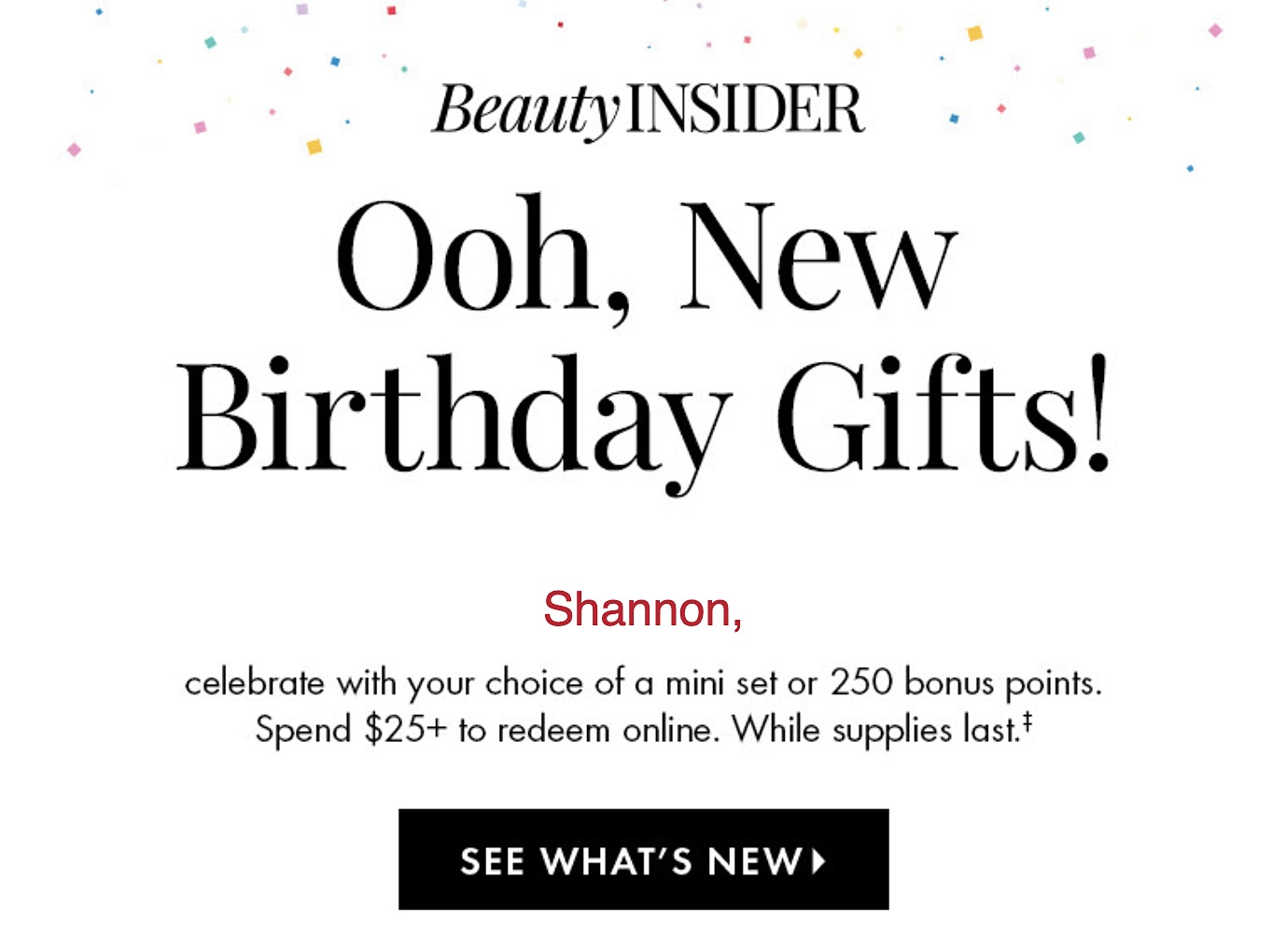
How to Get Started with Email Marketing
Your email marketing efforts are an extension of your brand and should be treated with the same care and attention as any other customer touchpoint.
Here’s how to get started:
Choose the Right Email Marketing Platform
Finding a quality email service provider for email marketing management will help ensure you create emails that subscribers enjoy.
Popular ESP options include Mailchimp and Constant Contact. These platforms are ideal for small- to medium-sized businesses due to their user-friendly interfaces and comprehensive feature sets.
For larger enterprises, platforms like Salesforce Marketing Cloud and HubSpot offer advanced functionalities that cater to complex marketing needs.
The right ESP provides the tools that allow you to create, personalize, and track your email campaigns.
Here are some features to consider:
- Deliverability: A platform known for reliable deliverability might increase the chances of your emails reaching the recipient's inbox rather than the spam folder
- List management capabilities: Tools for organizing and segmenting your email list can make your campaigns more targeted and personalized
- Customization and personalization options: Tailoring emails to address your audience's needs and interests can lead to higher engagement
- Analytics and reporting tools: Detailed analytics enable you to understand email performance and guide data-driven improvements
- Integration with other tools: An ESP that integrates with your existing tools could streamline your workflow and consolidate data management
- Scalability: As your needs grow, an ESP that can handle increasing volumes and complexities will be beneficial for your evolving marketing strategies
Build Your List Through Marketing Tactics
Try these marketing tactics to help build your email list.
Lead Magnets
Offer a lead magnet to encourage signups. A lead magnet is an incentive that attracts subscribers.
The incentive could be anything from a free ebook to a product discount. The key is to offer something valuable enough to compel users to give you their contact information.
For instance, clothing brand Mango offers new newsletter subscribers a 10% discount on their first order.

Image Source: Brevo
Membership Signups
Offer customers an opportunity to join a loyalty or membership program. By signing up, customers can access exclusive offers, content, or rewards.
Nike demonstrates a streamlined signup process with its premium membership form.
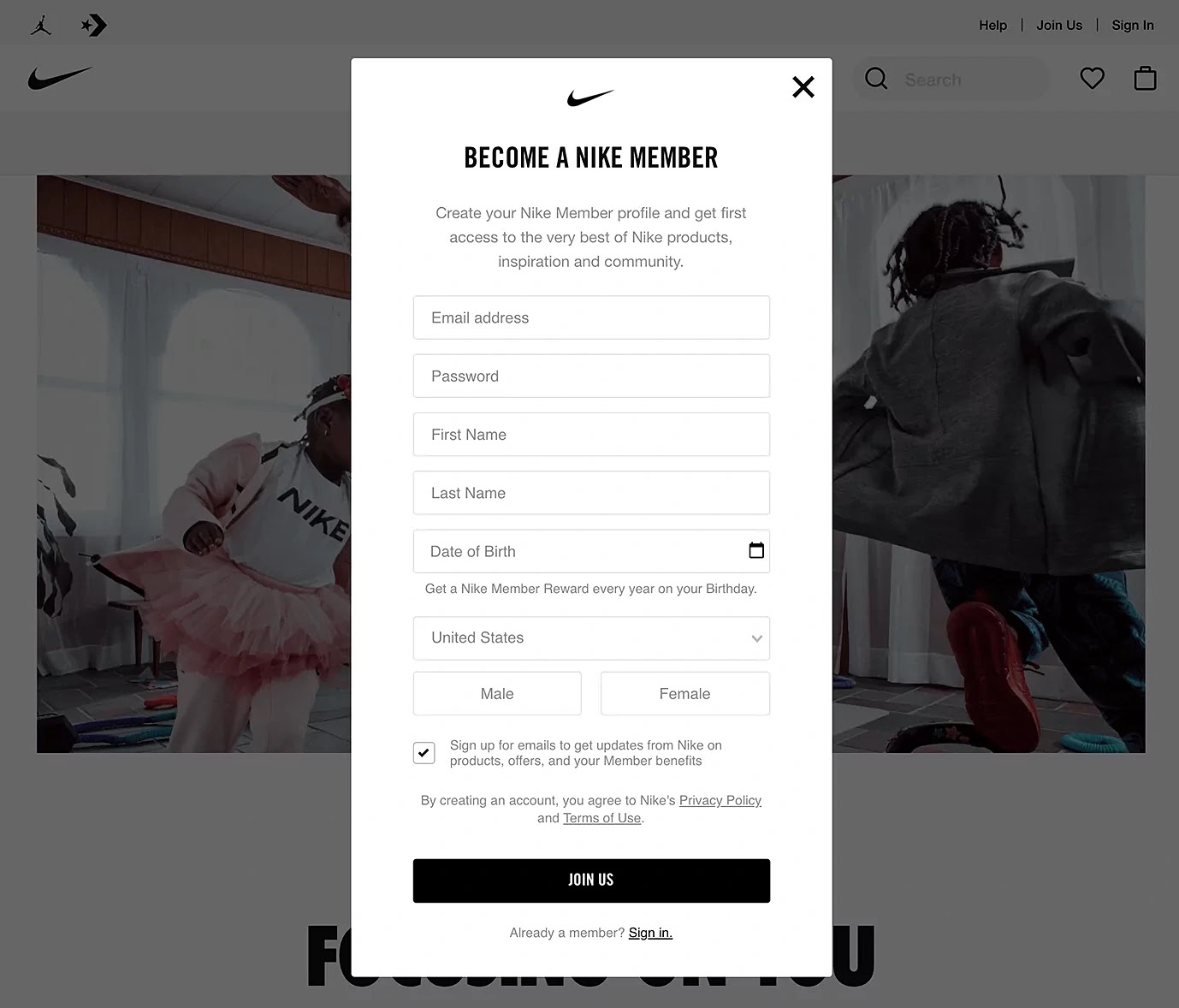
Image Source: Justinmind
Here are some tips on fine-tuning the email signup process:
- Ensure the signup process is user-friendly by allowing users to sign up using their existing email accounts. This method minimizes the information they need to enter manually, helping to streamline the signup experience and potentially increase subscribers.
- Offer multiple registration options, such as email, social media, or mobile phone numbers, accommodating different user preferences
- Provide instant, clear feedback upon registration, like a confirmation message or welcome email, to confirm successful signup and initiate engagement
A smooth signup experience can help set the stage for email engagement by creating a positive first impression and establishing trust.
Giveaways
Organize contests that reward participants with entries for subscribing to your newsletter.
Offer this as an explicit choice, ensuring compliance with opt-in regulations and maintaining transparency.
For example, in the following Super Bowl ticket giveaway created in collaboration with RafflePress, there are six ways to enter the competition, including subscribing to a newsletter.
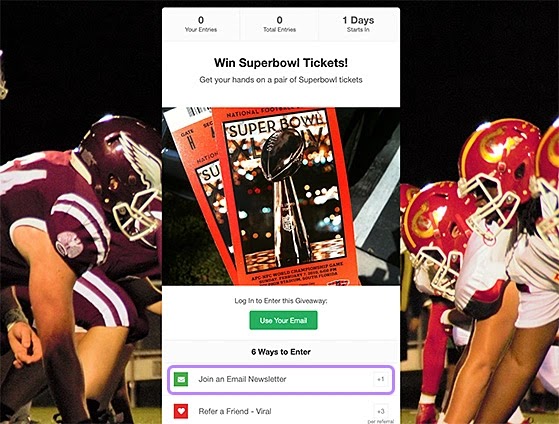
Image Source: RafflePress
Signup Forms
Strategically place email signup forms across your website, blog, and social media platforms, making them easily accessible to potential subscribers.
Adding a well-designed signup form to your website enhances the user experience by making it easy and efficient for visitors to subscribe to your newsletter or services.
By streamlining the process and minimizing required steps, users may be more likely to complete the action, leading to higher conversion rates.
For example, including a simple form with just an email address field on the main page allows visitors to quickly sign up without navigating away, keeping them engaged and reducing drop-offs.
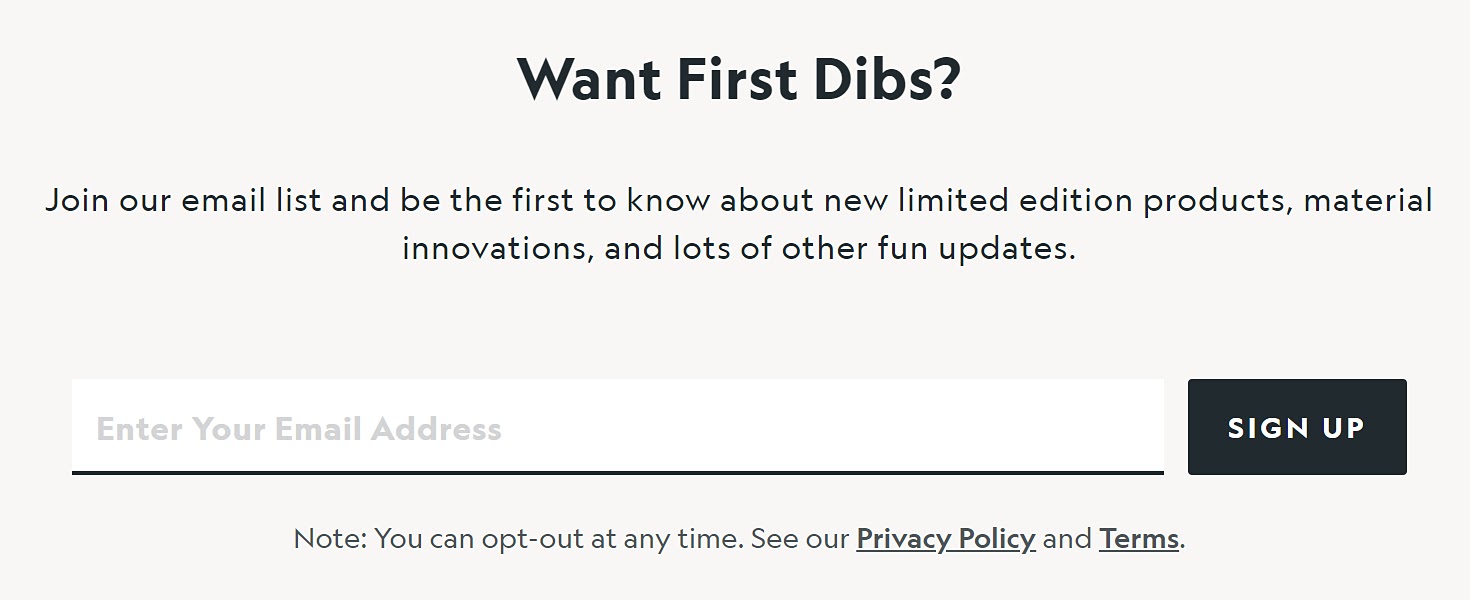
Understand Email Marketing Regulations and Compliance
Navigating email marketing regulations helps you build trust with your audience and avoid legal complexities.
For instance, you'll need to adhere to General Data Protection Regulation (GDPR) guidelines for recipients in the European Union and CAN-SPAM Act requirements for those in the U.S.
It's crucial to be aware of these differing regulations to ensure global compliance in your email marketing practices.
CAN-SPAM Act (U.S.)
This act sets rules for commercial emails.
CAN-SPAM Act does the following:
- Enforces transparency in commercial emails
- Requires clear sender identification
- Mandates an easy opt-out mechanism
GDPR (European Union)
GDPR focuses on how to use personal data.
GDPR in the EU includes the following regulations:
- Insists on explicit consent for email marketing
- Demands transparency in personal data use
- Makes privacy policy easily accessible
CASL (Canada)
Canada’s anti-spam legislation (CASL) has regulations for consent and compliance:
This legislation:
- Governs commercial electronic messages
- Needs express consent for email communications
- Provides straightforward unsubscribe options
Privacy and Electronic Communications Regulations (PECR) (United Kingdom)
PECR works alongside the GDPR and stipulates specific rules for marketing emails.
Working alongside GDPR in the U.K., PECR:
- Requires consent for marketing emails
- Enforces clear opt-out mechanisms in communications
Spam Act 2003 (Australia)
This act outlines requirements for sending commercial emails, highlighting a need to:
- Obligate consent from email recipients
- Enforce clear identification of the sender
- Include a simple unsubscribe feature
Seek Subscriber Consent
Adopt these specific practices to ensure your email marketing adheres to legal requirements and considers your audience's broad preferences.
Obtain explicit permission before you add individuals to your email list. Collect users' contact details via opt-in forms.
FreshBooks showcases an excellent email marketing opt-in form. It requests user consent for newsletter subscriptions, ensuring compliance with email marketing laws.
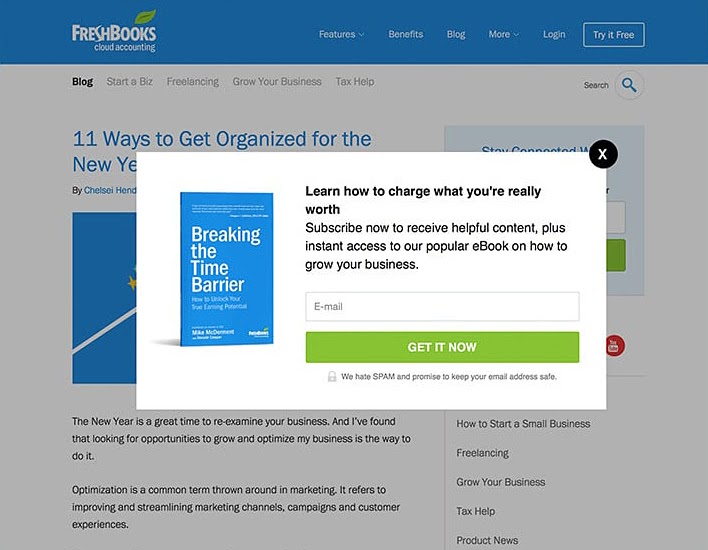
Image Source: Campaign Monitor
Provide an Unsubscribe Option
A clear, easy-to-find unsubscribe process reassures customers that you respect their decision to leave your email list.
After opting out, Rip Curl's customers receive a confirmation message that allows them to resubscribe if they change their minds.
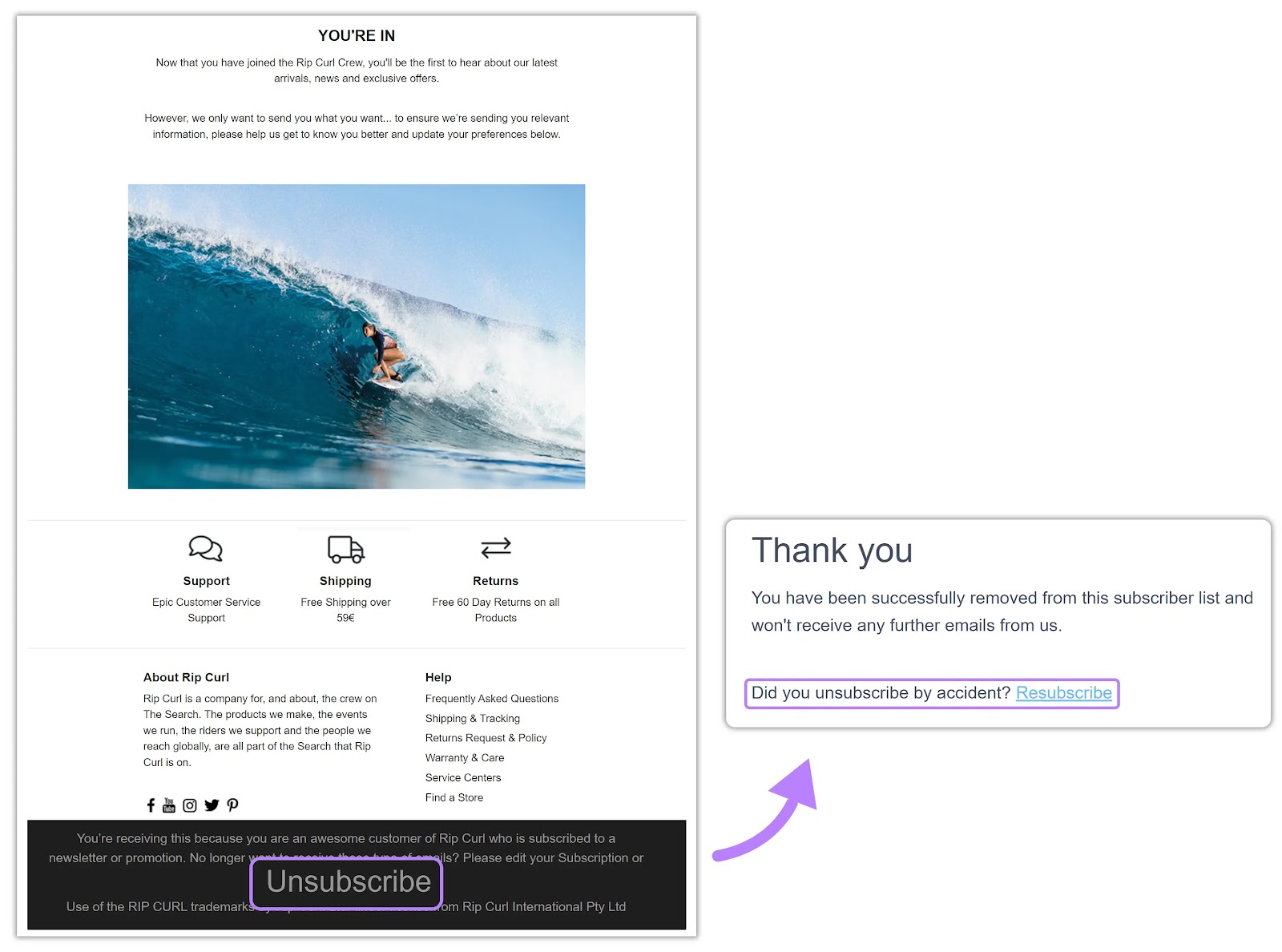
Identify Your Email as an Advertisement
Transparency in email marketing fosters trust and complies with legal standards that call for clear identification and communication of the sender's intent.
Plus, the CAN-SPAM laws require that you make it clear to the recipient that your message is an advertisement.
This doesn't mean you must bluntly state, "This email is an advertisement."
Rather, avoid potentially deceptive language that could mislead recipients into thinking they're receiving a personal message instead of promotional.
Sixty-nine percent of email recipients report spam based solely on the subject line.
A straightforward and honest subject line is not just a legal formality—it's crucial for your email's success and your brand's reputation.
Sephora’s email campaign subject lines get straight to the point without misleading subscribers.
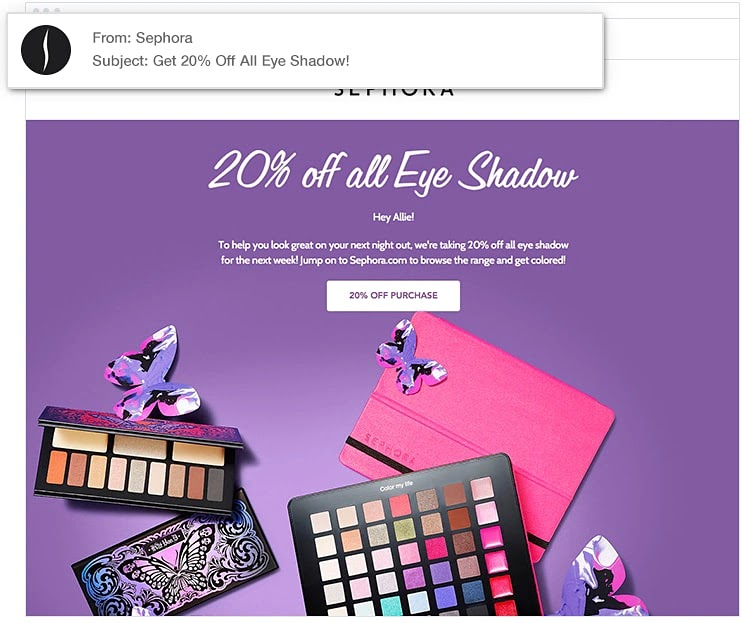
Image Source: Campaign Monitor
Understand Email List Opt-Ins
Building an effective email list is a crucial aspect of email marketing, especially for beginners. A key part of this process involves opt-in methods, which are ways you obtain permission from individuals to send them emails.
There are two types of opt-ins you can offer to potential subscribers:
- Single opt-in (SOI): In SOI, a user's email is added to your mailing list as soon as they submit their email address. There is no follow-up confirmation required. SOI is straightforward and can rapidly grow your list.
- Double opt-in (DOI): DOI adds an extra step. After submitting their email, the user receives a confirmation email and must click a link to verify their subscription. This method ensures higher quality lists but can slow down list growth.
A Litmus study suggests a shift in the effectiveness of these methods. While DOI has been favored for its precision, SOI shows promising results. Specifically, SOI emails have been found to yield an 80% higher ROI compared to DOI emails.
Unless you must adhere to regulatory compliance in your target country, SOI might be a more effective approach.
How to Create an Email Marketing Strategy
Creating an email marketing strategy is more than writing content and pressing ‘send.’ Here’s a look at what it’ll take to create an effective email strategy:
Set Clear Goals and Objectives
Clear goals can guide your email marketing strategy. And make it easier to measure success and make necessary adjustments.
The SMART goals framework is widely recognized for bringing structure and trackability to your objectives.
Here's what the framework stands for and how it applies to email marketing:
- Specific: Create a clear focus for your campaigns by defining precise targets, such as increasing newsletter signups by a certain percentage. This specificity can help align your team and resources towards a common aim.
- Measurable: Goals need to be quantifiable to track progress. Measurable objectives enable you to assess your campaigns' performance and understand the impact of your strategies.
- Achievable: Setting realistic objectives is key to maintaining motivation and momentum. Goals that align with your resources and capabilities are more likely to be attained, providing a sense of accomplishment and direction for future efforts.
- Relevant: Your goals should be closely tied to your broader business objectives so your email marketing efforts contribute to your business's overall success and growth.
- Time-bound: Assigning deadlines helps maintain focus and accountability. Time-bound goals encourage a sense of urgency and efficiency, making organizing and prioritizing tasks easier.
Let's say "GreenEarth Organics," a fictional eco-friendly skin care brand, sets a SMART goal for its email marketing campaign.
Its goal is "To increase newsletter signups by 15% over the next three months, enhancing our customer base and engagement."
- Specific: The goal targets a precise increase in newsletter signups
- Measurable: The 15% increase is quantifiable
- Achievable: Assuming GreenEarth Organics has a robust marketing strategy, a 15% increase is realistic
- Relevant: More newsletter signups directly contribute to customer engagement and potentially more sales, aligning with the broader business objective of growth
- Time-bound: The three-month time frame sets a clear deadline for achieving this goal
Develop a Content Calendar for Email
Here’s a look at how to use a content calendar to improve your email marketing strategy:
- Outline key dates: Align your email campaigns with product launches, major events, promotional periods, seasonal events, and holidays to maximize relevance and engagement
- Balance frequency: Carefully consider how often you send emails. Over-sending can lead to high unsubscribe rates, but too little can lose audience interest. Find a sweet spot based on subscriber engagement and response.
- Stay adaptable: Be ready to adjust your content calendar in response to market trends or changes in customer feedback. Flexibility keeps your content relevant and engaging.
Create In-Depth Personas
A customer persona is a research-driven profile that represents a segment of your audience, whether fictional or realistic. Personas describe user preferences, purchasing behavior, and other characteristics.
Here are some data points to include in your personas:
- Demographics: Age, gender, location, occupation, etc.
- Psychographics: Values, lifestyle, hobbies, and interests
- Pain points: Challenges and pain points your products or services can address
- Motivations: Factors that compel your audience to make purchasing decisions
- Communication preferences: Preferred contact method (email, text) and communication style
Acquire this data from your website analytics, customer service inquiries, and audience’s purchase history to identify pain points, trends, and preferences. Also, consult surveys and feedback forms if you have them.
Using Market Explorer can also help you analyze market trends and audience behaviors by studying your competitors.
Discover information such as audience demographics, online behavior, and more to help you create relevant emails and effective A/B testing strategies.
Let’s take a deeper look:
Log in to your Semrush account and choose the “.Trends” drop-down from the left-hand navigation.
Then click “Market Explorer.” Now, you can create a list of up to 100 domains for analysis, find competitors of a business, or analyze a whole category.
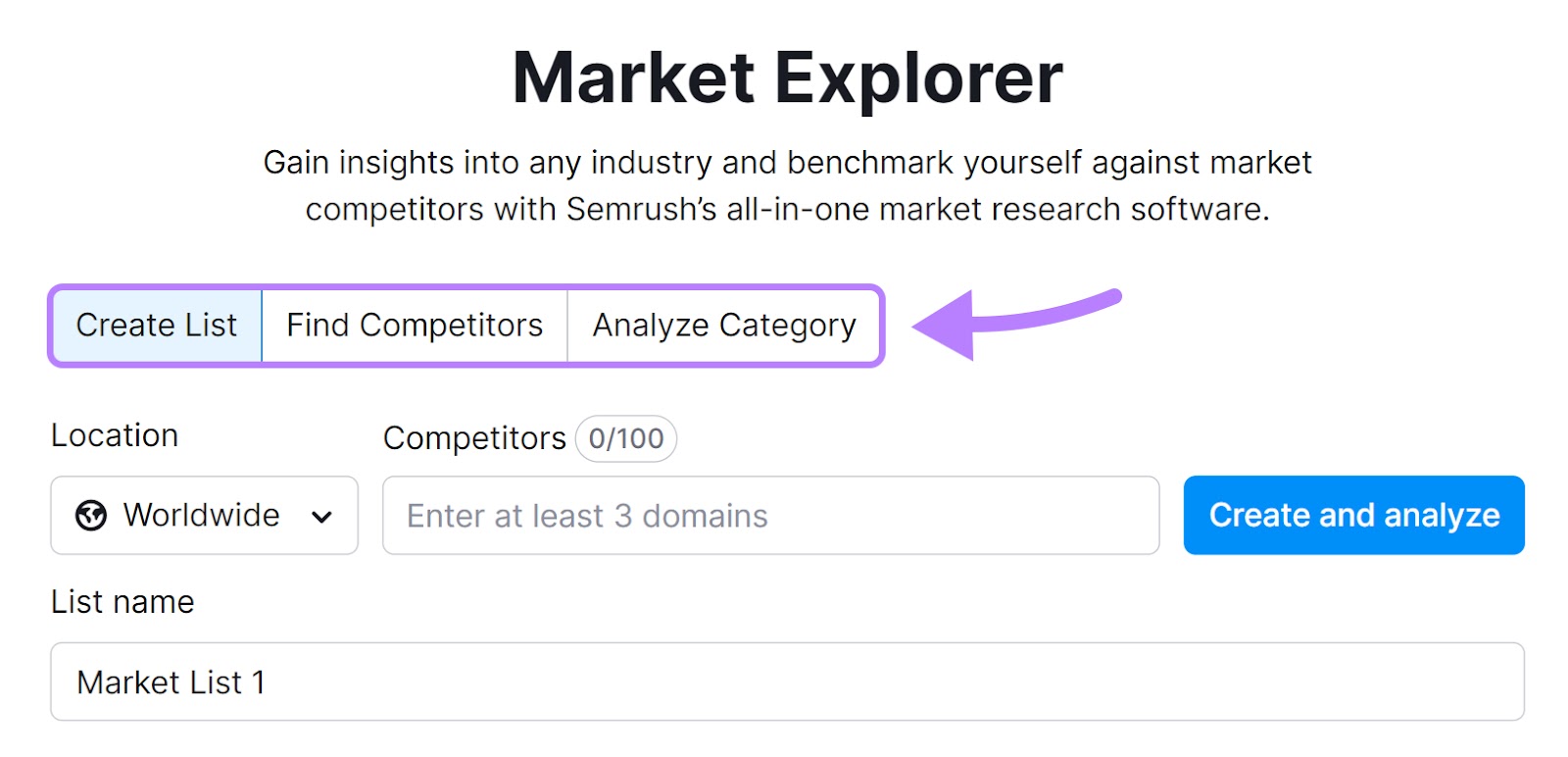
For this example, we’ll analyze a category. Click the “Analyze Category” tab, and then select the category of your choice from the menu.
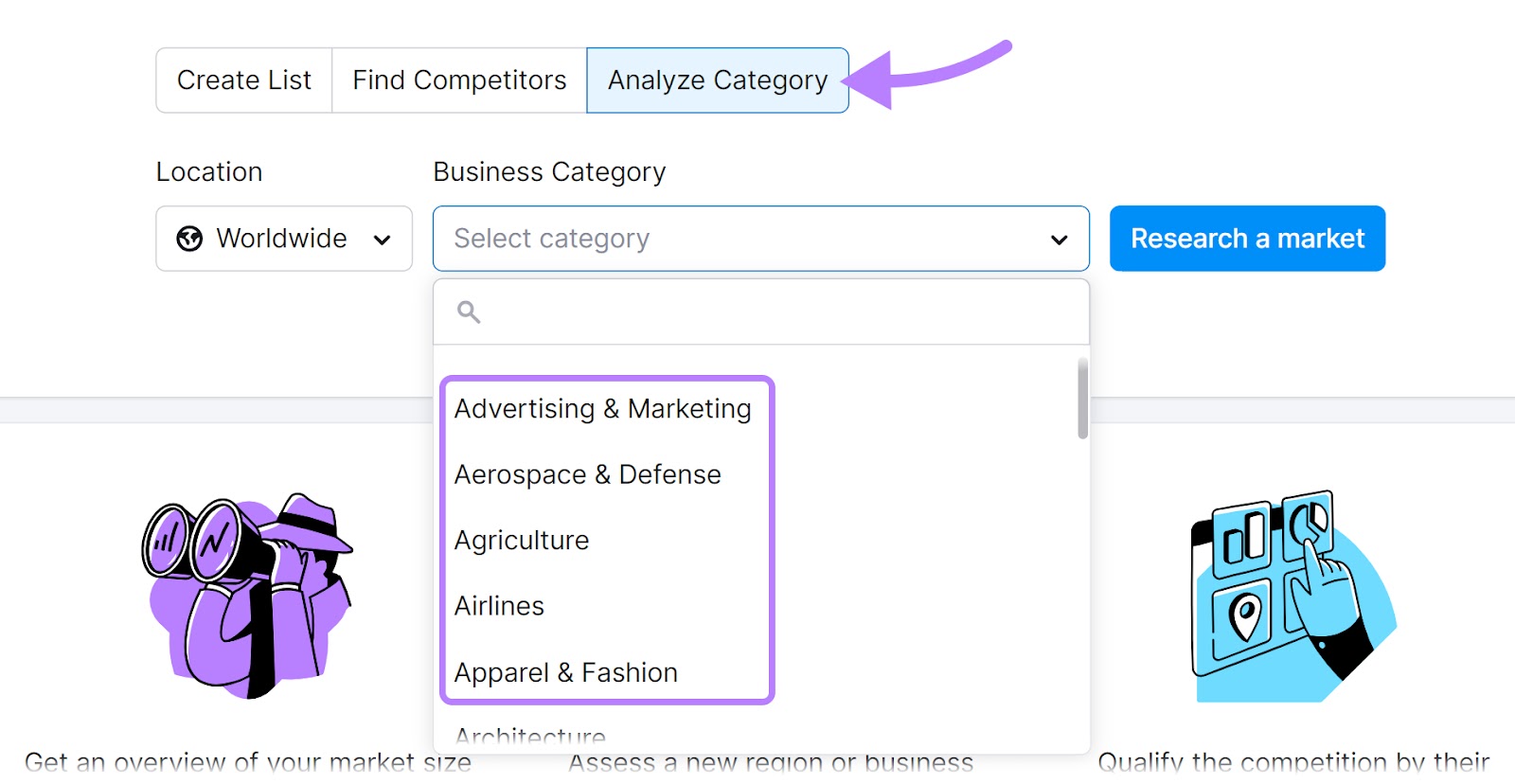
Next, click “Research a market.”

Now, you’ll see “Market Summary,” which will provide a quick look at the category’s size, cost, and key players.
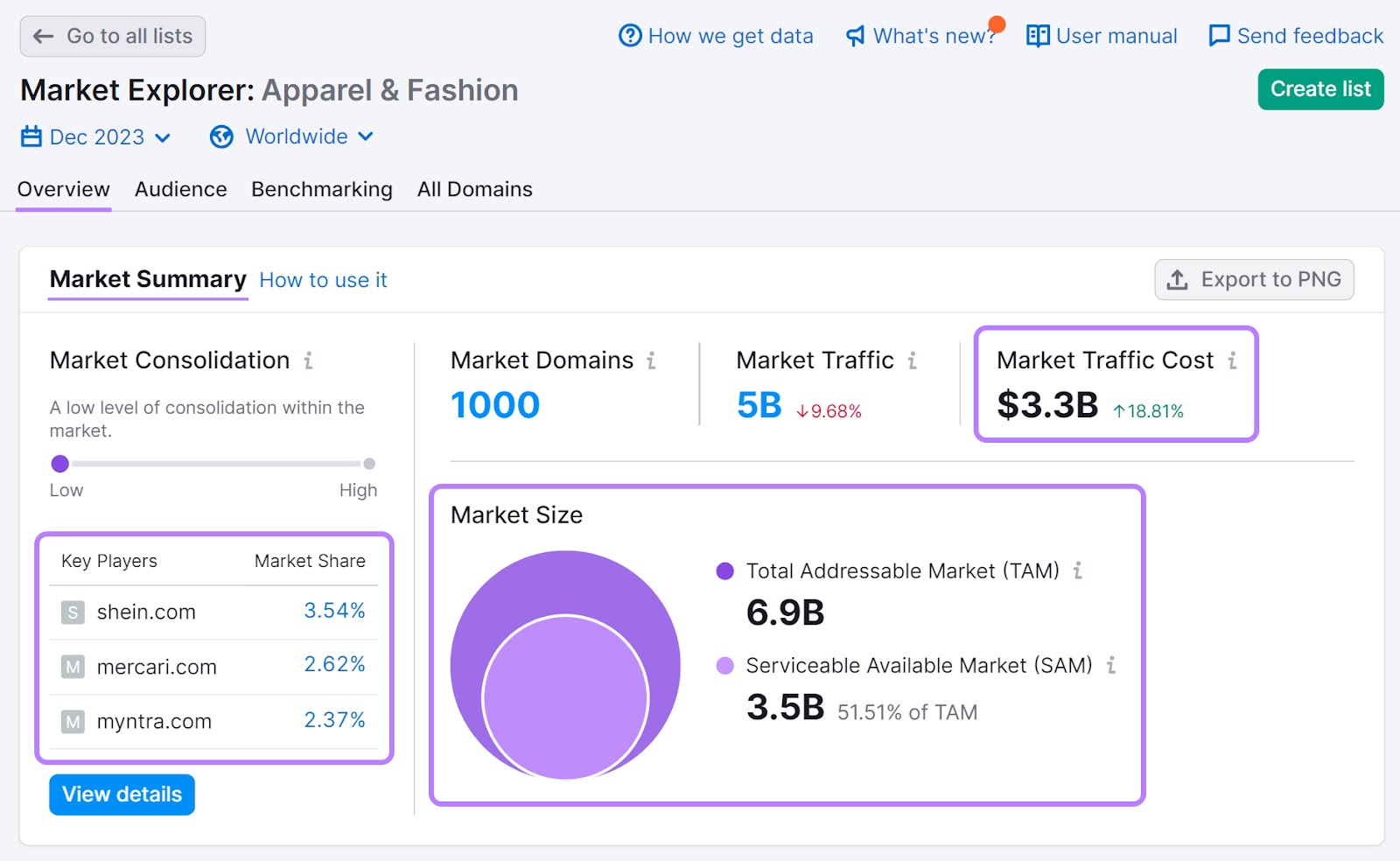
Scroll down to “Growth Quadrant” for a visual representation of the competitive landscape.
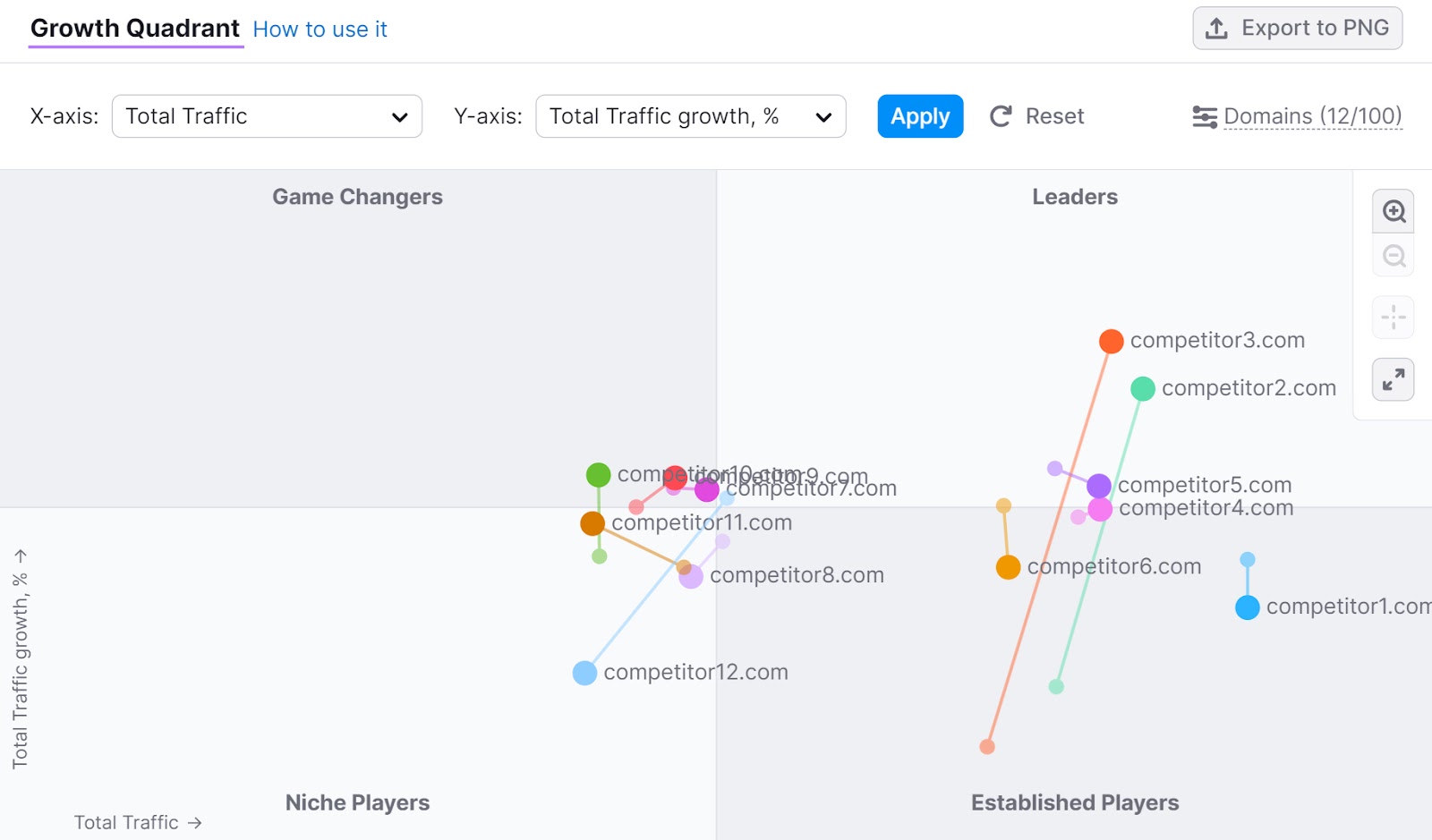
If you navigate to the “Audience” tab at the top of the page, you’ll see an in-depth report on your target audience. This can help you build personas easily and accurately.
You’ll see an overview of your target audience’s most relevant characteristics in the “Market Audience Summary.” This includes an overview of their demographics, socioeconomics, and behavior relevant to your category.
Understanding and using this data to build your customer personas can help in tailoring your email content to specific audience preferences.
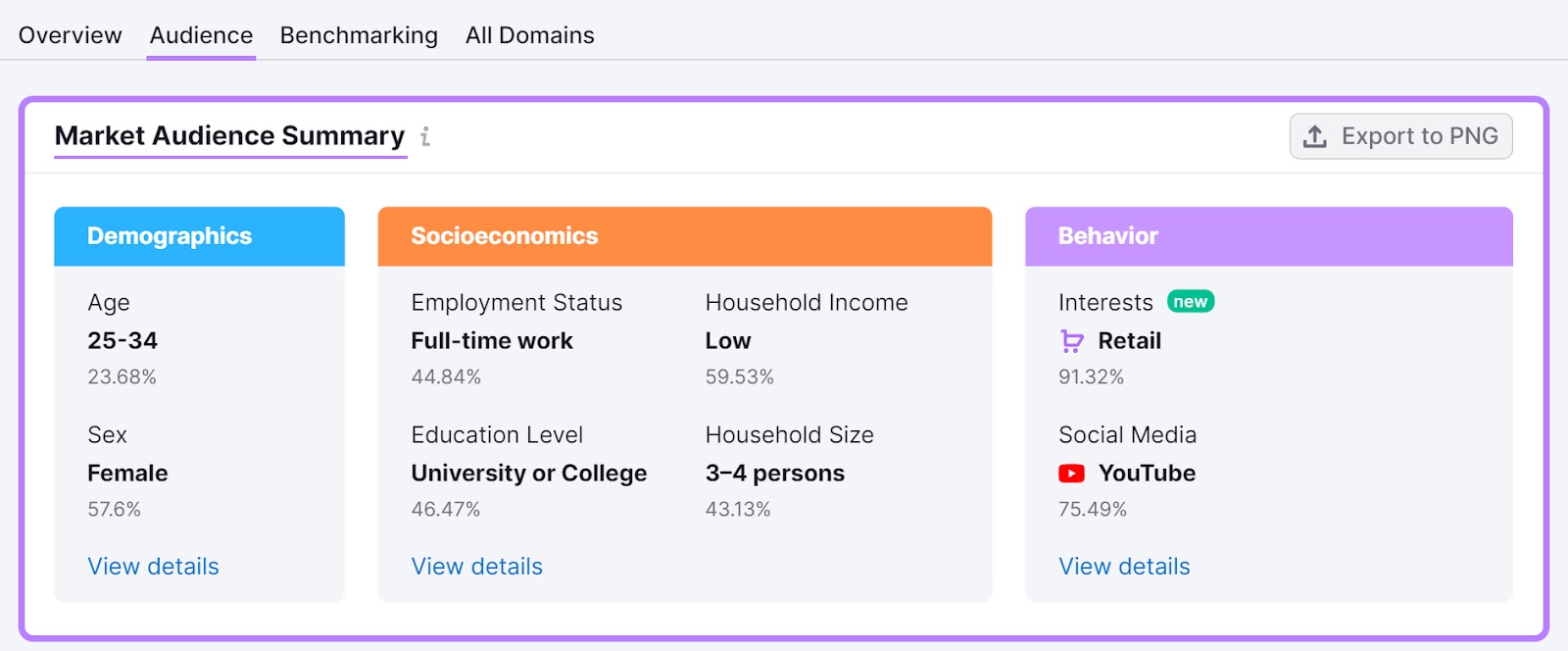
Personalize Your Email Content
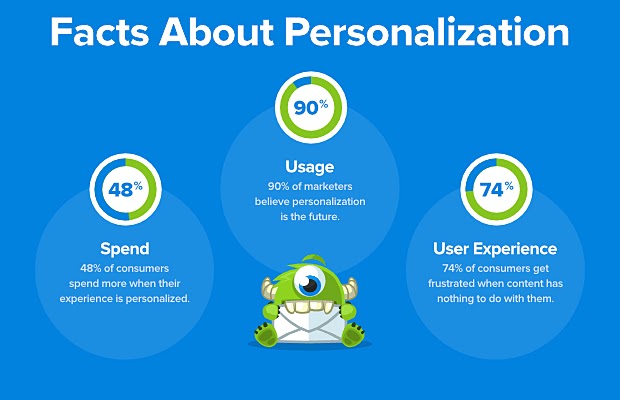
Image Source: OptinMonster
Seventy-four percent of people say they don't like getting content that doesn't matter to them. Your email marketing should match your audience's interests.
Once you create detailed personas, use this data to craft highly personalized email content that resonates with each group.
This could include a mix of beginner and advanced personalization tactics:
- Personalize the greeting: Use the recipient's name in the email greeting to create a more personal connection
- Segment your audience: Divide your email list into segments based on demographics, purchase history, or engagement to send more targeted and relevant content
- Use behavioral triggers: Send emails triggered by the recipient's actions, such as a welcome email after signing up or a follow-up email after a purchase
- Include personalized recommendations: Suggest products, services, or content based on the recipient's past behavior or preferences
Use Professional Email Signatures
Incorporating a professional email signature at the end of your email communications can serve as a digital business card.
An email signature provides your recipients with your contact information, reinforces your brand identity, and can even contain calls to action.
Semrush’s Email Signature Generator is a free tool that can help you easily create a personalized and professional signature. Add a touch of branding to every email you send.
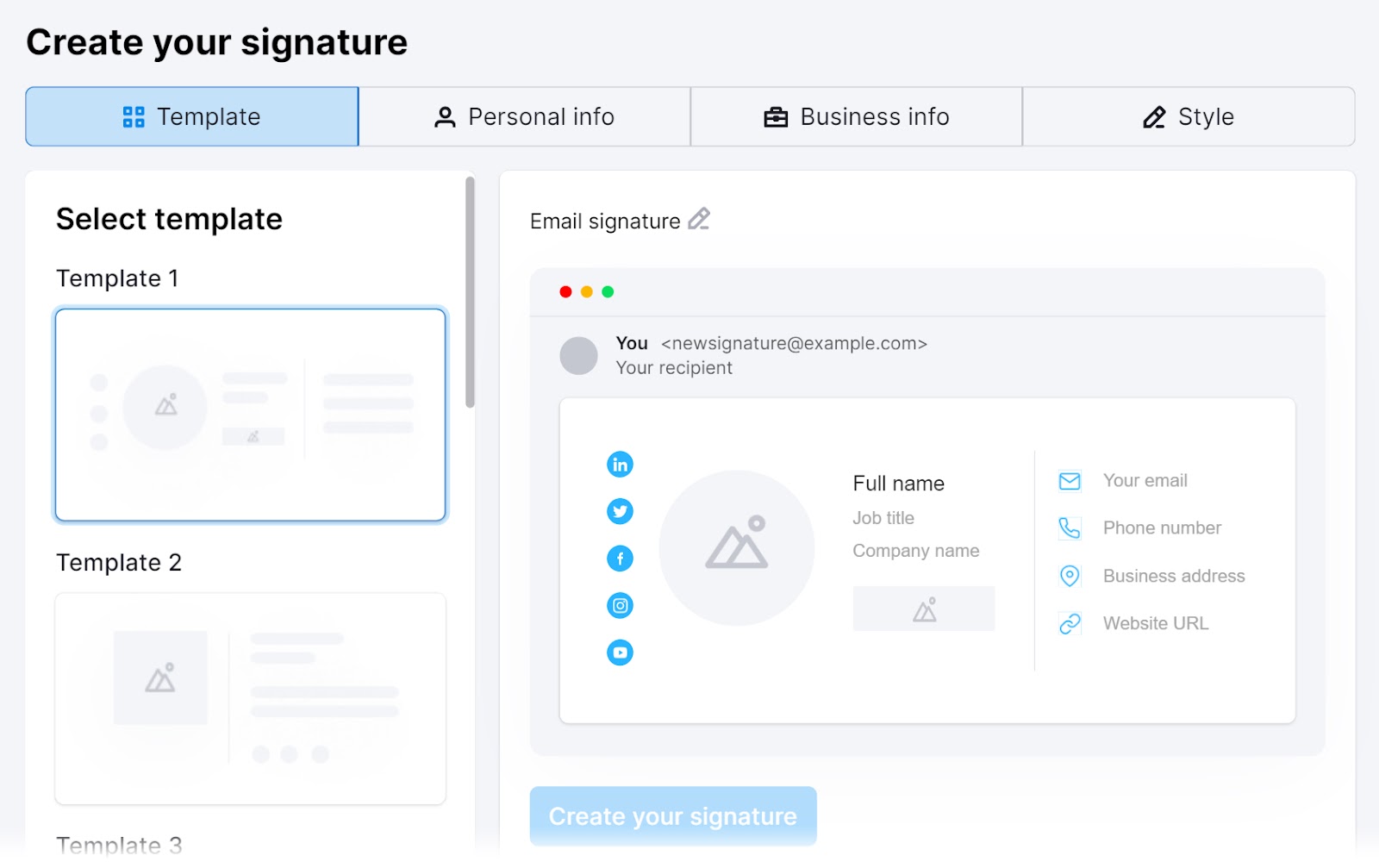
Create a User-Friendly Email Design
Creating an engaging and user-friendly email design is essential for successful email marketing.
A well-designed email not only captures attention but also encourages readers to take action.
Here are some actionable tips to enhance your email designs:
- Prioritize readability: Use a clean font and font size that is easy to read on all devices
- Color palette: Select a color scheme that reflects your brand identity. Use contrasting colors for CTAs to make them stand out
- Use high-quality images: Incorporate high-resolution images (your own or stock images) that are relevant to your content
- Leave whitespace: Include plenty of whitespace around elements to create a clean look and help guide the reader’s eye through the email
- Avoid overcrowding: Keep the design simple and focused. Too many elements can confuse the reader and dilute the main message.
- Ensure accessibility: Use alt text for images and ensure a high contrast ratio for text to keep your emails accessible to all
Write Compelling Email Copy
Crafting email copy that connects with your audience is crucial. Here are some key points to consider:
- Consider the purpose of your email: Is your goal to increase engagement, share important news, or promote a new product? Ensure your content directly aligns with this goal, helping readers clearly understand your message.
- Highlight the benefits: Emphasize what your readers stand to gain from your offer. Whether it’s insights, savings, or unique opportunities, make the advantages clear and compelling.
- Maintain your brand's voice: Ensure your email reflects your brand's unique personality. Use a tone consistent with your overall branding to reinforce identity and maintain communication consistency.
- Write a compelling subject line: Your subject line is the first thing your audience sees, so it needs to be clear and compelling. Stick to 30 to 50 characters or four to seven words for best results.
- Include engaging content: Keep email content short and sweet, and ensure it matches your promise in the subject line and heading. According to Boomerang, emails between 50 to 125 words tend to perform best.
- Add a call-to-action: Your CTA tells your readers what to do next and can help you get conversions, from “Read more” to “Sign up now.”
The SEO Writing Assistant tool can help you create compelling email content for your audience. It gives you real-time suggestions to improve your email copy's readability and engagement.
Log in to Semrush and scroll down to the “Content Marketing” tab on the left side of your screen.
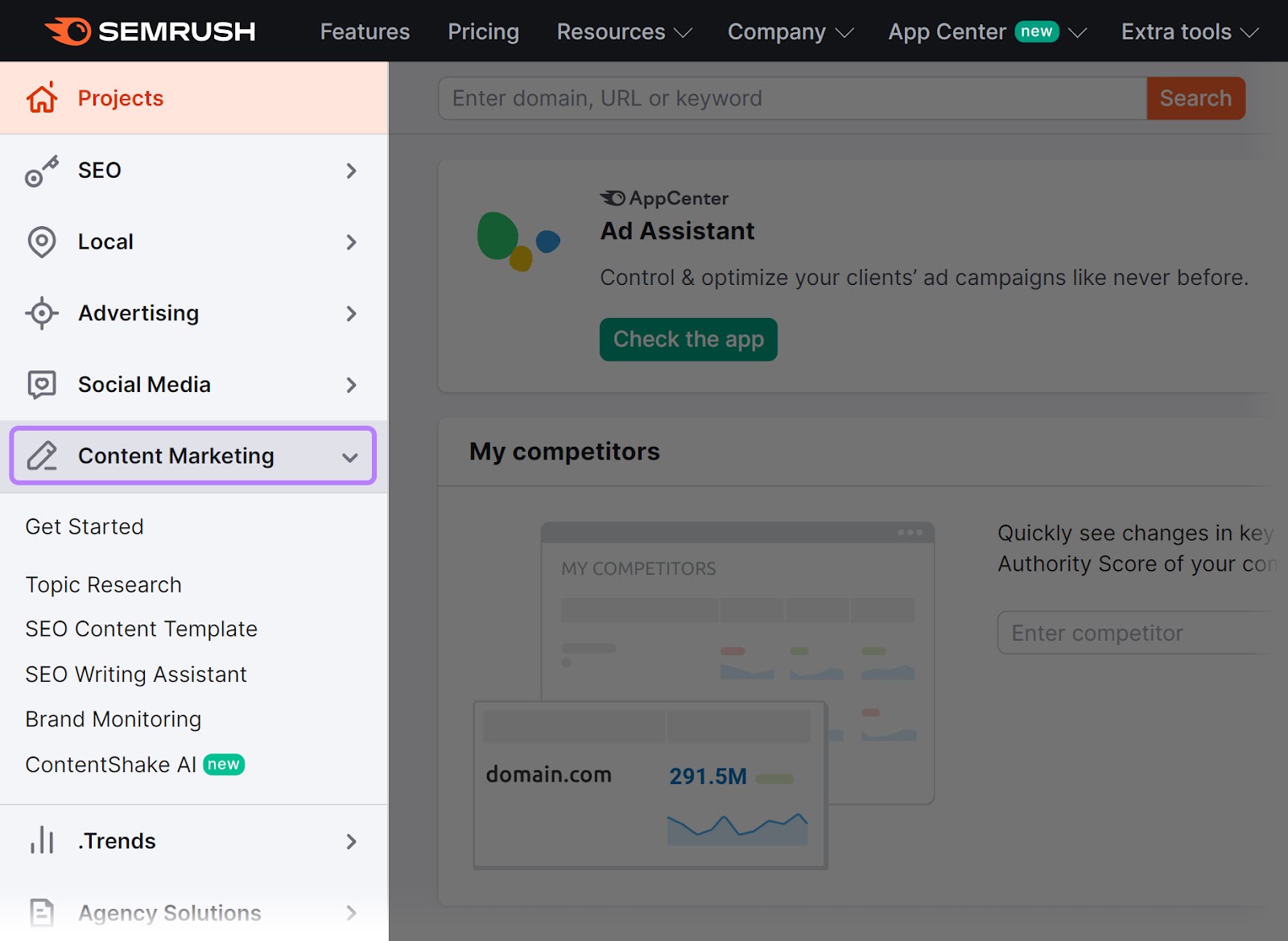
Choose the “SEO Writing Assistant” from its drop-down menu.
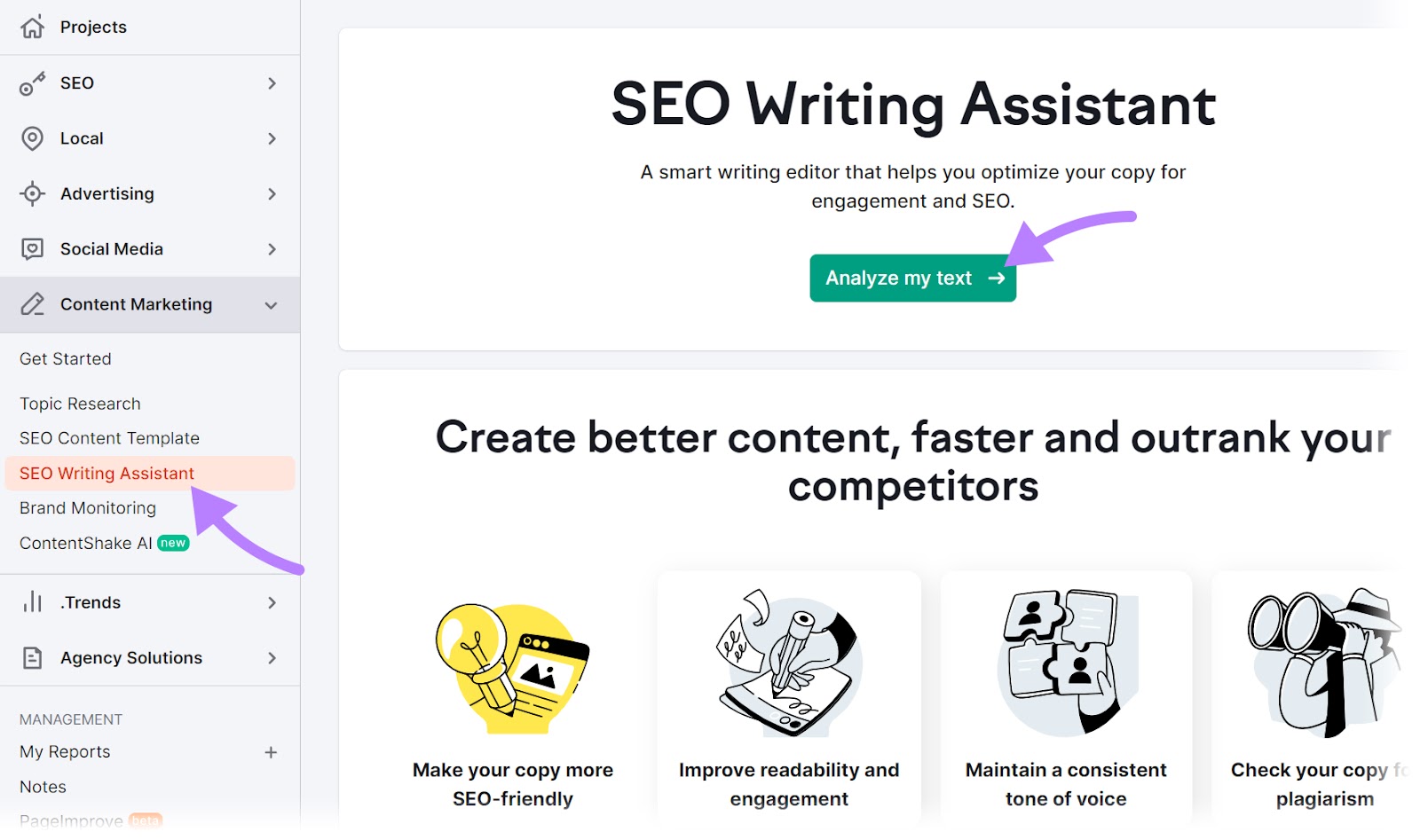
Click the “Analyze new text” button.
Add your content to the content block and set your target audience. The tool will require you to add keywords, but for email marketing purposes, this can be your email’s topic.
Now, click “Get recommendations.”
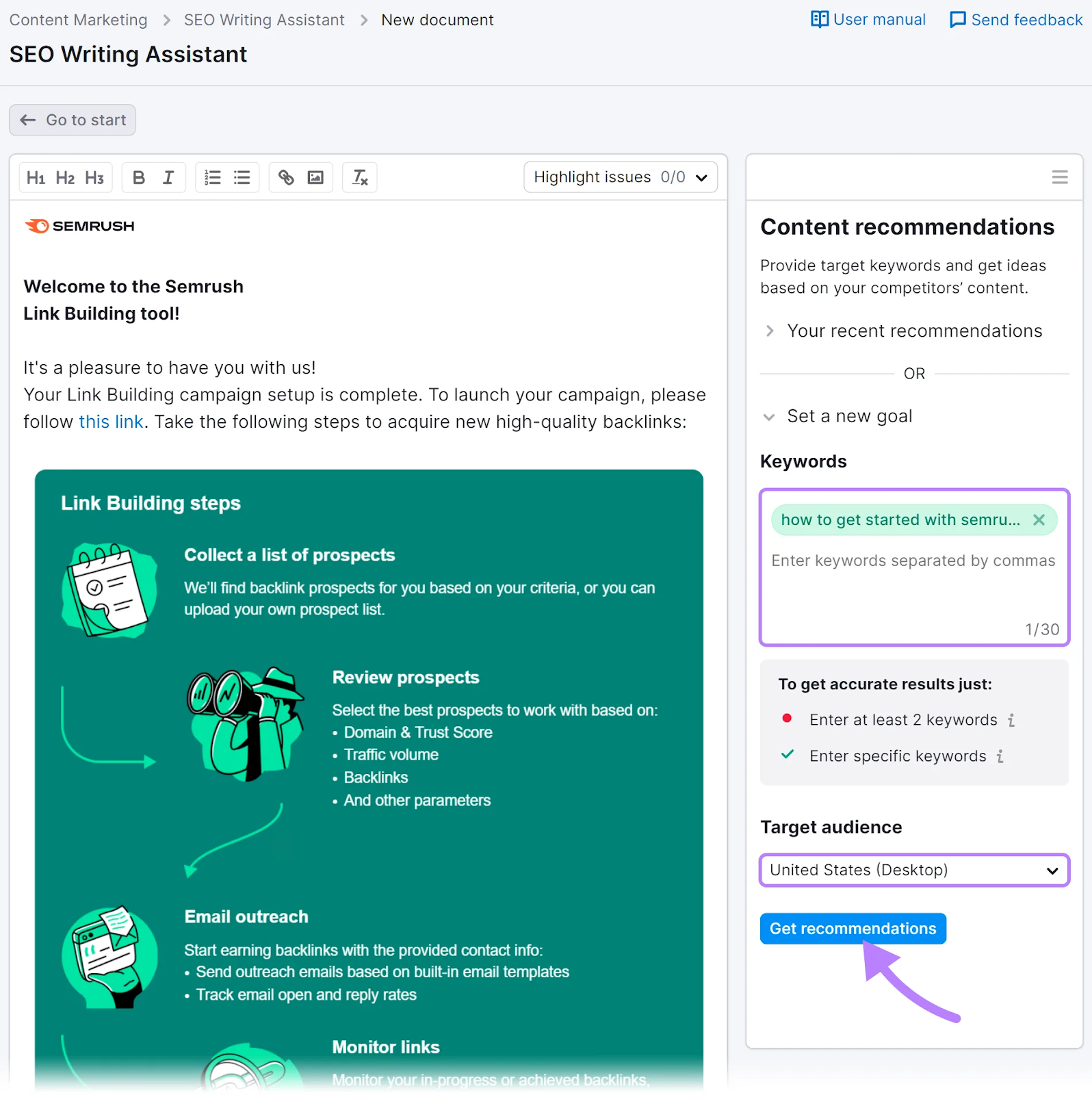
Check any issues with your content by scrolling down or clicking “Readability,” “SEO,” “Tone of Voice,” and “Originality.”
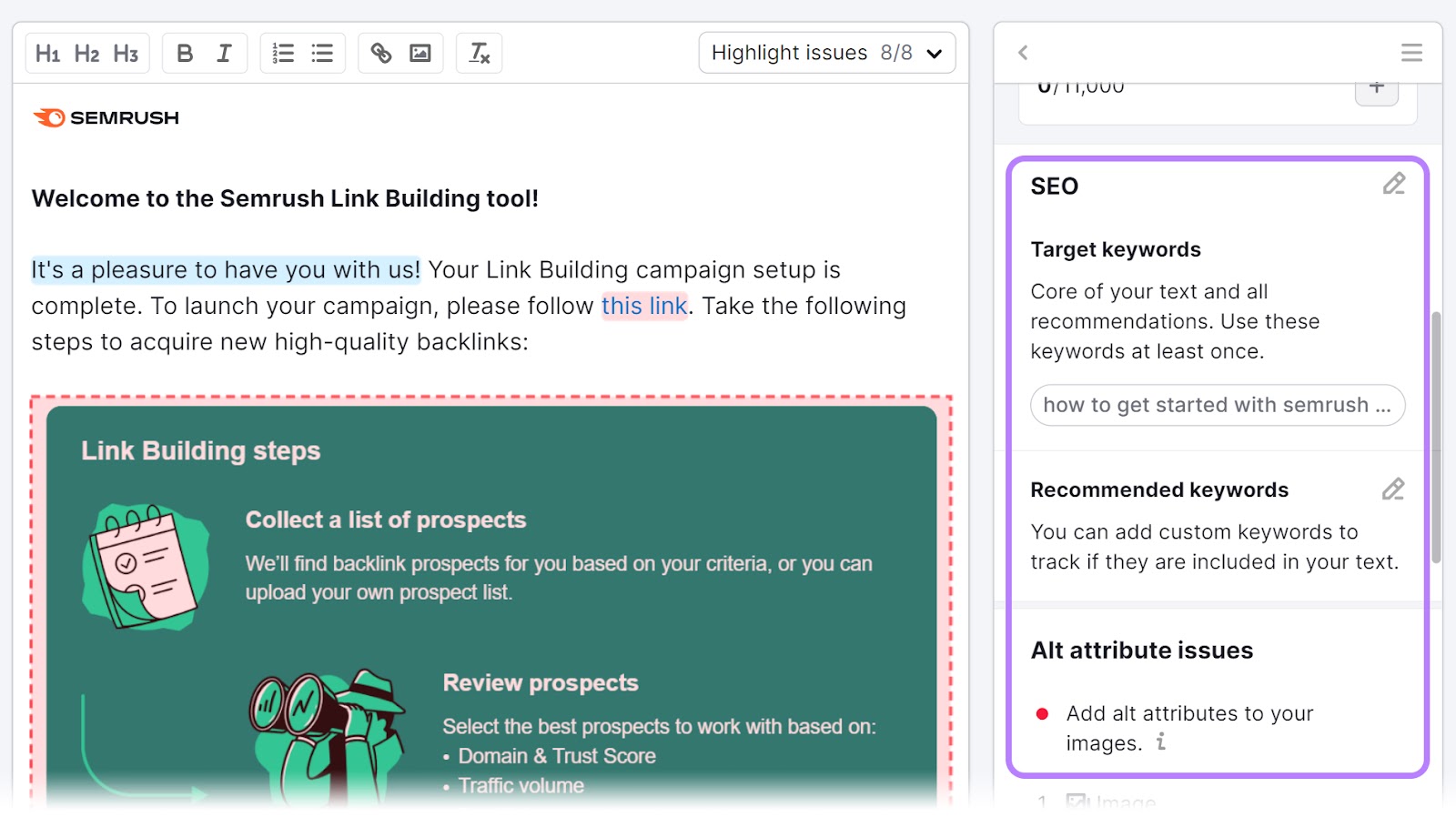
You can also ask the Smart Writer to rephrase or compose the content or give a specific prompt by clicking “Ask AI.”
Advanced Email Marketing Tactics
Once you’ve got the basics down, it’s time to level up your email marketing strategy with advanced tactics.
Segment Your Email List
Email marketers who segment their lists can see a potential increase in email marketing revenue by up to 760%.
Email list segments are smaller groups of subscribers categorized by a specific characteristic or behavior.
Consider dividing your list into segments based on:
- Demographics
- Behaviors
- Past purchases
For example, if you sell baby items, you could segment people who bought diapers and send them emails about related products such as diaper wipes and cream.
Pet company Chewy segments customers by those who have added products to their shopping cart but didn’t complete their purchase.
After a certain amount of time, this triggers an automated email like the one below:
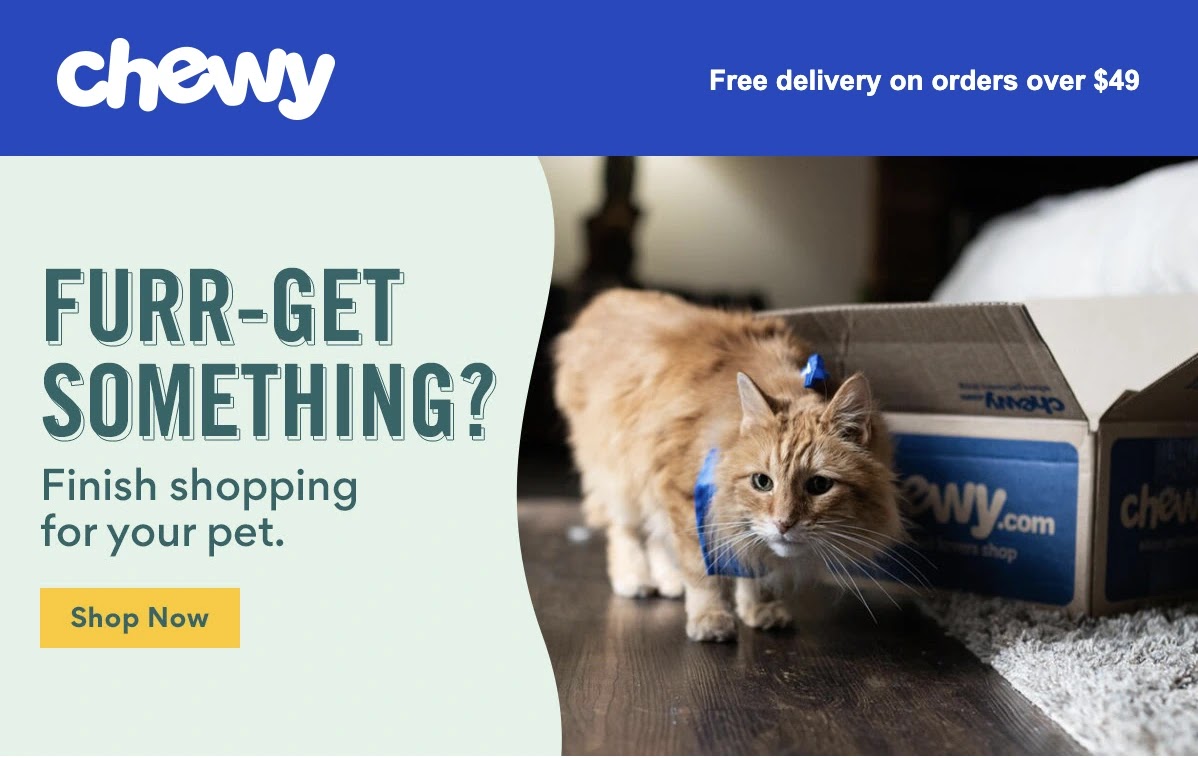
You could also segment subscribers based on how often they visit your website or particular pages/categories. Re-engage those who haven't visited your website recently and reward top spenders with VIP discounts.
Segmentation tools can help you craft email campaigns that align with each group's interests and behaviors. Most email marketing providers offer built-in segmentation capabilities.
A/B Testing and Analytics for Email Optimization
A/B testing, or split-testing, involves comparing two versions of an email to see which one performs better.
According to Benchmark, you can increase your email ROI by as much as 37% with A/B tests.
Split-testing involves altering one variable at a time—such as the subject line, design, or call-to-action—and sending each version to a segment of your email list.
A/B testing can help you:
- Improve open rates: Identify which email elements increase the frequency of your audience opening your emails
- Boost click-through rates: Determine which email versions generate more clicks, enhancing engagement and potential conversions
- Understand audience preferences: Gain insights into the content, design, or calls-to-action that resonate most with your audience through A/B testing
- Make data-informed decisions: Use A/B test results to inform your email strategy choices, tailoring them to your recipients' preferences
- Refine emails effectively: Use recipient response rates to adjust and optimize your emails for better performance
To create your first A/B test, start with a hypothesis about what change might improve your email engagement. Then, create two versions of your email (one with the change and one without), send them out, and analyze the results.
In A/B testing, "control" refers to the original version of your content, used as a benchmark to measure the impact of changes. It's the standard against which you compare the "test" version.
For example, say you want to test the effectiveness of different email subject lines. Your hypothesis might be that a more personalized subject line will lead to higher open rates.
To test this, you’d create two versions of your email: Version A (control): "Our Latest Summer Collection Is Here!" and version B (test): "John, Dive into Our Exclusive Summer Collection!"
Automate Your Email Marketing with Autoresponders
Maintain consistent communication and save time by automating routine emails.
Autoresponders are automated emails triggered by specific audience actions like signing up for a newsletter or making a purchase.
Ulta Beauty sends customers an email immediately after a purchase to let them know they’ve received their order and are working on shipping it out as soon as possible.
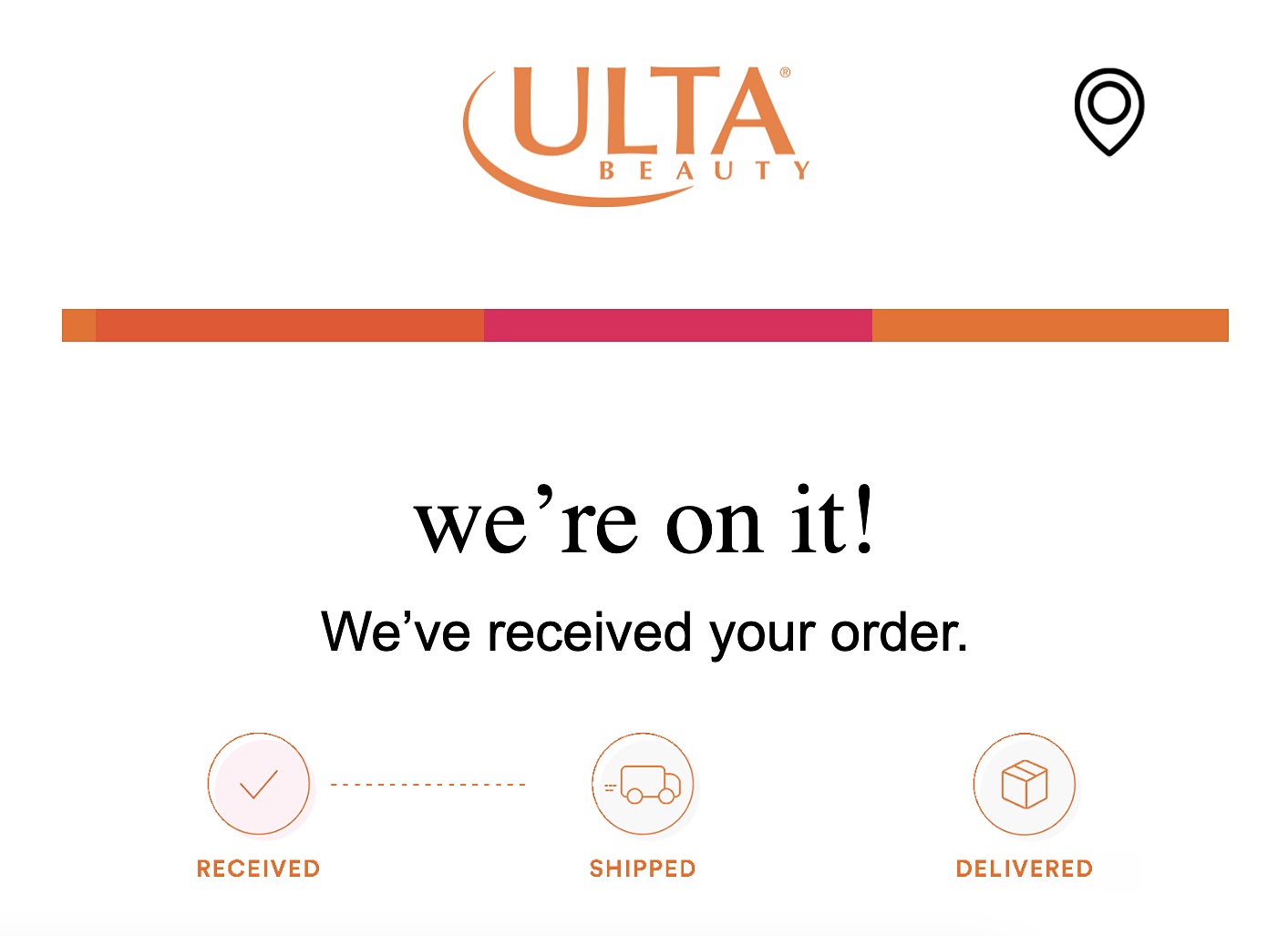
Using autoresponders can lead to a more efficient email strategy, providing timely and relevant communication to your subscribers.
Leverage Email Sequences
Email sequences, often called email drip campaigns, consist of a series of carefully planned and timed emails.
These emails are sent based on predefined intervals or specific actions subscribers take.
The primary purpose of email sequences is to facilitate systematic and strategic communication with your audience.
They serve three essential functions:
- Nurturing leads
- Educating subscribers
- Encouraging sales
For example, consider how Dollar Shave Club entices past customers with an email sequence that starts with a 'We miss you' message and a special deal.
Each subsequent email builds on this narrative, updating customers on new services and reminding them of the brand's value.
This strategy not only re-engages past customers but also encourages them to reconsider the brand's offerings.
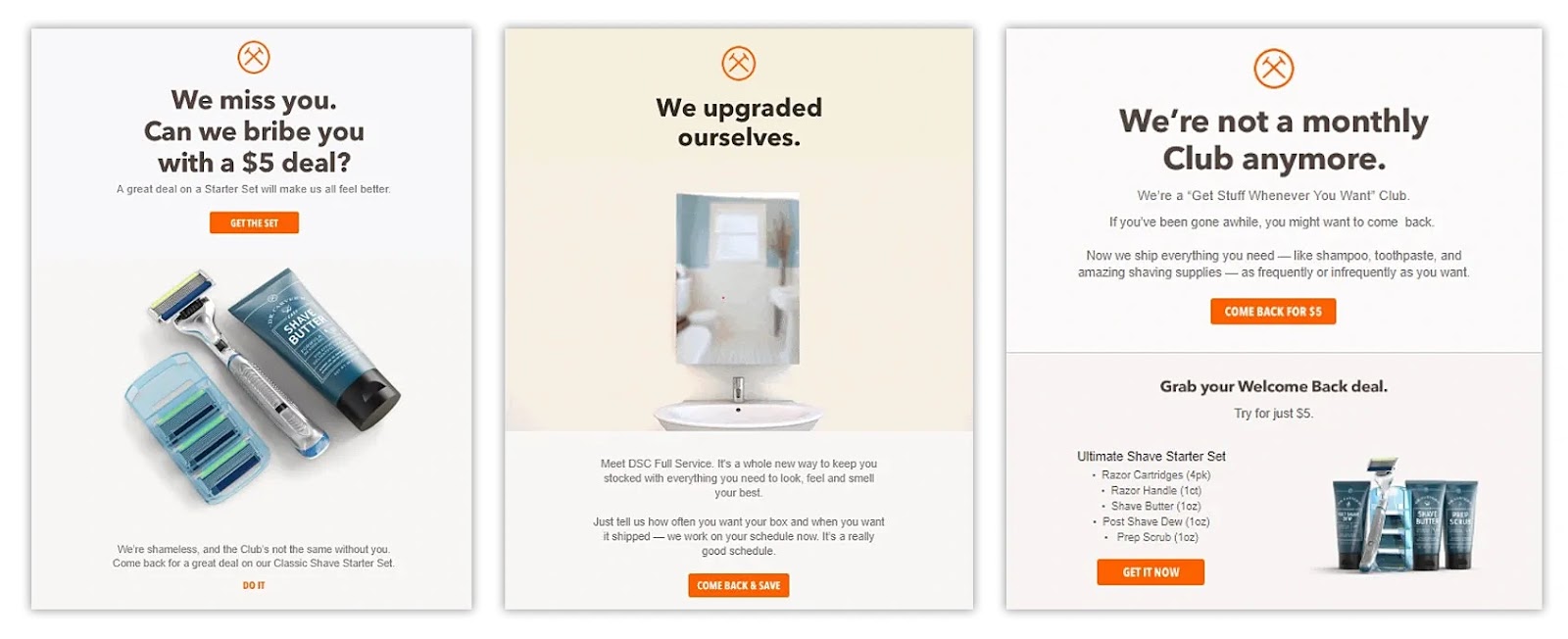
Image Source: Constant Contact
The versatility of email sequences allows businesses to achieve various goals, whether guiding potential customers through a sales funnel, providing onboarding information, or delivering a comprehensive course.
Measure the Success of Your Email Marketing
It’s essential to know what’s working—and what isn’t—so you can refine your email strategy.
Key Performance Indicators (KPIs) for Email Marketing
Several KPIs can provide insights into the effectiveness of your email marketing campaigns.
Monitoring these metrics can help you understand how well your emails are performing and where adjustments might be needed.
Your KPIs for email marketing could include:
- Open rate: The average open rate across industries is 21.33%. A good email open rate lies somewhere between 17%-28%
- Click-through rate (CTR): According to a study, the average email CTR is 2.6%-3 percent.
- Bounce rate: The average bounce rate is 2.57%, according to research by GetResponse
- Unsubscribe rate: According to GetResponse, the average unsubscribe rate is 0.1 percent
While industry, frequency, quality, and more factor heavily into your results, knowing industry standards will give you an idea of what to aim for with your KPIs.
Analyze and Interpret Email Marketing Data
Analyzing email marketing data involves more than just looking at numbers. It’s about understanding the story behind these metrics.
- Trend analysis: Analyzing patterns can help shape future email strategies, ensuring they align with what resonates most with your audience. For example, you might notice that emails featuring user-generated content receive higher click-through rates, suggesting your audience values relatability.
- Segmentation analysis: This analysis goes beyond numbers; it reveals your subscribers' diverse preferences and behaviors. Tailoring your approach to these segments allows you to deliver more personalized and engaging content.
- A/B testing results: Review the outcomes of A/B tests. Pinpoint the changes that had a positive impact on email performance.
Data-driven decisions can refine your email marketing strategy and help you tailor your email marketing for better engagement.
Ask questions that reveal user behavior and preferences.
Here are some examples:
- Which email elements get the most clicks?
- Which subject lines resonate the most with your audience?
- Which emails convert the most?
- Which email types lead to the most unsubscribes and spam complaints?
Use data, including unsubscribe rates, bounce rates, and low engagement, to identify campaign areas needing improvement.
Email Marketing Best Practices and Tips
To get the most out of your email marketing strategy, follow these best practices:
Proofread and Test Your Emails
- Subscribe to your service and see if your emails and sequences work correctly
- Test emails, forms, and links in different browsers or email software systems
- Review your emails for spelling or grammatical errors
- Ensure the emails work on all mobile devices.
Regularly Clean Your Email List
- Use your email marketing platform's tools to detect and remove subscribers who no longer engage
- Establish a routine, perhaps quarterly, to clean your list and keep it up-to-date
- Implement confirmation emails for new sign-ups and quickly remove any undeliverable addresses. Tools like Semrush's email verifier can streamline this process.
Re-Engage Inactive Subscribers
- Design targeted email campaigns with enticing content and offers to recapture the attention of inactive subscribers
This email by Misguided is a great example of a re-engagement campaign. Light humor and free delivery are used to win back customers.

Image Source: Sendlane
- Trigger these specialized campaigns for subscribers inactive over a certain period using automated workflows
Create a Feedback Loop
- Incorporate a mechanism within your emails that encourages feedback when subscribers unsubscribe
- Regularly assess the feedback to understand why subscribers opt out and use this insight to refine your email marketing approach
Create an Effective Email Marketing Strategy with Semrush
Email marketing is an effective way to connect with your audience, improve retention, and increase sales.
To boost your efforts, take advantage of writing tools, competitive analysis, and email marketing tools.
Use Market Explorer to create accurate personas based on competitive analysis and SEO Writing Assistant to craft targeted, engaging content. Lastly, use Email Verifier to keep your email list clean and effective.
These tools, alongside the strategies covered above, will help you elevate your email marketing strategy and achieve better audience engagement.
This post was updated in 2023. Excerpts from the original article by Danni White may remain.
